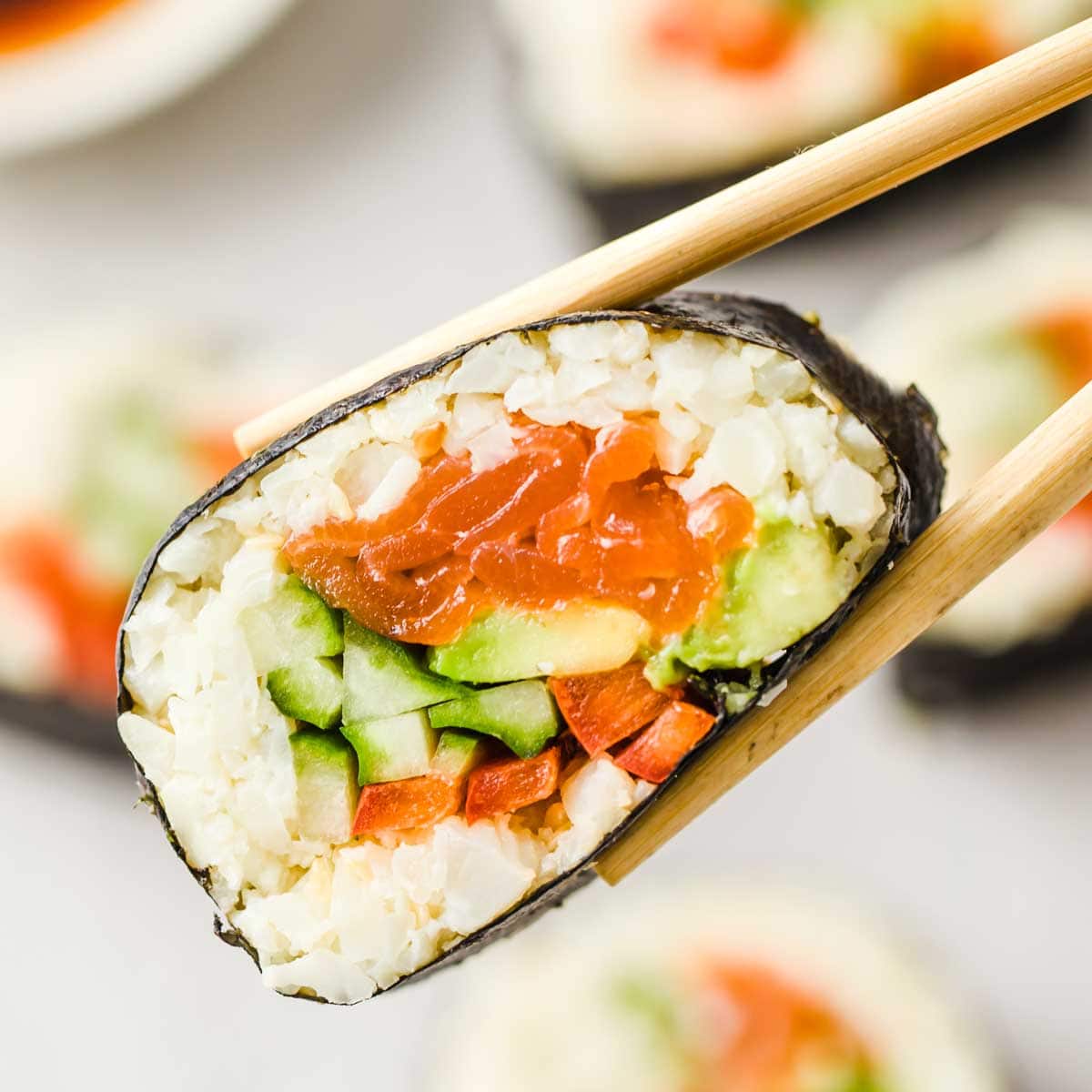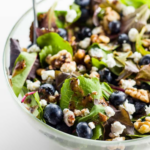Craving sushi but committed to the Banting lifestyle? Fear not! This guide unveils the secrets to crafting delicious, low-carb sushi that satisfies your cravings without derailing your diet. We’ll explore clever ingredient swaps, master rolling techniques, and discover a world of flavorful, healthy fillings, all while staying true to the principles of the Banting diet. Prepare to embark on a culinary adventure that’s both satisfying and surprisingly simple.
From understanding the core tenets of the Banting diet and its compatibility with sushi to mastering the art of creating cauliflower rice and other low-carb alternatives, this guide offers a comprehensive journey. We’ll delve into the nutritional comparisons between traditional and low-carb sushi, providing clear visual aids to showcase the macronutrient differences. Learn to expertly roll your creations, exploring various shapes and sizes, and discover a treasure trove of filling ideas that are both delicious and perfectly aligned with the Banting principles. Finally, we’ll elevate your presentation with visually appealing plating suggestions and complementary low-carb sauces.
Understanding Low-Carb Sushi & the Banting Diet

The Banting diet, a low-carbohydrate, high-fat (LCHF) eating plan, emphasizes minimizing carbohydrate intake to induce ketosis, a metabolic state where the body burns fat for energy instead of glucose. This approach contrasts sharply with traditional sushi, which often relies heavily on carbohydrates from rice. Understanding these fundamental differences is key to creating delicious and effective low-carb sushi within the Banting framework. This involves carefully selecting ingredients and substituting high-carbohydrate components with low-carb alternatives to maintain the nutritional benefits and satisfying texture of the dish while adhering to the Banting principles.
The Banting diet prioritizes whole, unprocessed foods, healthy fats, and moderate protein intake. It aims to regulate blood sugar levels, improve insulin sensitivity, and promote weight loss. Traditional sushi, while often perceived as a healthy option, can be surprisingly high in carbohydrates, particularly from white rice, which forms the base of most rolls. This high carbohydrate content directly contradicts the core tenets of the Banting diet. Low-carb sushi, therefore, necessitates a complete overhaul of the traditional recipe, replacing white rice with low-carbohydrate alternatives like cauliflower rice, shirataki noodles, or even thinly sliced cucumbers or zucchini. This allows for a flavorful and texturally similar experience while maintaining alignment with the Banting dietary principles.
Nutritional Differences Between Traditional and Low-Carb Sushi
Traditional sushi relies heavily on white rice, providing a significant source of carbohydrates. This, combined with the often-used sauces and added sugars, results in a dish with a relatively high glycemic index. In contrast, low-carb sushi dramatically reduces the carbohydrate content by replacing the rice with low-carb alternatives. This shift significantly alters the macronutrient profile, resulting in a higher fat and protein content, which is more aligned with the Banting diet’s goals of ketosis and satiety. The reduction in carbohydrates also minimizes the blood sugar spike typically associated with traditional sushi. This is crucial for individuals following the Banting diet, who aim to maintain stable blood sugar levels and avoid insulin resistance.
Macronutrient Comparison of Sushi Ingredients
The following table illustrates the stark differences in macronutrient content between traditional and low-carb sushi ingredients. Note that these values are approximate and can vary depending on specific ingredients and preparation methods.
| Ingredient | Traditional Sushi (g/serving) | Low-Carb Sushi (g/serving) | Difference (g/serving) |
|---|---|---|---|
| Rice (1 cup) | 45 Carbohydrates, 0.5 Fat, 3 Protein | 0 Carbohydrates, 0 Fat, 0 Protein (Cauliflower Rice Substitute) | 45 Carbohydrates, 0.5 Fat, 3 Protein |
| Avocado (1/2) | 14 Carbohydrates, 14 Fat, 2 Protein | 14 Carbohydrates, 14 Fat, 2 Protein | 0 |
| Salmon (3oz) | 0 Carbohydrates, 10 Fat, 20 Protein | 0 Carbohydrates, 10 Fat, 20 Protein | 0 |
| Soy Sauce (1 tbsp) | 2 Carbohydrates, 0 Fat, 1 Protein | 2 Carbohydrates, 0 Fat, 1 Protein | 0 |
| Nori (Seaweed Sheet) | 1 Carbohydrate, 0 Fat, 1 Protein | 1 Carbohydrate, 0 Fat, 1 Protein | 0 |
Suitable Low-Carb Sushi Ingredients
Embarking on a Banting-friendly sushi journey requires clever substitutions to maintain the delightful textures and flavors while adhering to the low-carbohydrate principles. This involves replacing traditional high-carb ingredients with suitable low-carb alternatives, maintaining the essence of the sushi experience. Let’s explore the possibilities.
Many traditional sushi ingredients are naturally low-carb and can be incorporated directly. However, the key challenge lies in replacing the rice, the foundation of most sushi rolls. Fortunately, several excellent alternatives exist, each offering a unique texture and culinary experience.
Low-Carb Sushi Rice Alternatives
Several low-carb options effectively mimic the role of rice in sushi, each offering a distinct textural experience. Choosing the right alternative depends on personal preference and desired outcome.
The following list details popular choices and their preparation methods. Remember that cooking times and textures can vary slightly depending on the specific product and your cooking equipment.
- Cauliflower Rice: Finely grated cauliflower mimics the texture of rice when cooked properly. Its mild flavor complements a wide range of sushi fillings. A vibrant white, it offers a slightly firmer texture than traditional rice. To prepare, pulse cauliflower florets in a food processor until they resemble rice grains. Sauté in a pan with a little butter or coconut oil until tender-crisp, about 5-7 minutes. Season lightly with salt and pepper.
- Shirataki Noodles: These noodles, made from the konjac yam, are nearly carbohydrate-free and offer a unique, slightly chewy texture. They absorb flavors well and work beautifully in sushi rolls. Their translucent, almost glassy appearance contrasts beautifully with colorful fillings. Before using, rinse shirataki noodles thoroughly to remove any excess odor. They don’t require cooking, but a quick sauté in butter or oil enhances their flavor and texture.
- Portobello Mushrooms: Large portobello mushroom caps, thinly sliced and marinated, can serve as a substantial and flavorful base for sushi. Their earthy flavor and meaty texture provide a unique twist on traditional sushi. Marinate sliced mushrooms in soy sauce, mirin, and ginger for at least 30 minutes before assembling your sushi. Grilling them lightly before adding to the roll adds depth of flavor.
Preparing Low-Carb Sushi Rice Alternatives
Precise preparation is crucial for achieving the desired texture and taste in your low-carb sushi. Overcooking can lead to mushiness, while undercooking results in a raw or unpleasant consistency.
The following recipes provide detailed instructions for preparing two popular low-carb sushi rice alternatives: cauliflower rice and shirataki noodles. Remember to adjust seasoning according to your preferences.
Cauliflower Rice Recipe
This recipe yields approximately 2 cups of cauliflower rice, sufficient for 2-3 servings of sushi.
- Wash and chop one large head of cauliflower into florets.
- Pulse the florets in a food processor until they resemble small rice grains. Avoid over-processing, as this can create a paste-like consistency.
- Heat 1 tablespoon of butter or coconut oil in a large skillet over medium heat.
- Add the cauliflower rice and sauté for 5-7 minutes, stirring frequently, until tender-crisp and lightly browned.
- Season with salt and pepper to taste. Allow to cool slightly before using in your sushi.
Shirataki Noodle Preparation
This method prepares a single package of shirataki noodles (typically around 7 ounces).
- Rinse the shirataki noodles thoroughly under cold running water to remove any residual odor. This step is crucial for a pleasant culinary experience.
- Drain the noodles completely.
- Heat 1 tablespoon of butter or coconut oil in a pan over medium heat.
- Add the drained shirataki noodles and sauté for 2-3 minutes, stirring occasionally, until heated through and slightly softened. Avoid overcooking, as this can result in a mushy texture.
- Season with a pinch of salt and pepper, or your preferred seasonings.
Low-Carb Sushi Rolling Techniques
Creating beautiful and delicious low-carb sushi involves mastering a few key rolling techniques. The process is surprisingly straightforward, and with a little practice, you’ll be crafting impressive sushi rolls perfect for the Banting lifestyle. This section details the steps involved in creating classic maki rolls, focusing on the visual aspects of each stage.
Basic Maki Roll Technique
The maki roll is the foundation of many sushi variations. This technique involves spreading a filling on a sheet of low-carb sushi substitute, such as nori seaweed or a large piece of thinly sliced cucumber, adding your fillings, and then carefully rolling it up into a tight cylinder.
- Step 1: Preparing the Ingredients: Imagine a vibrant spread of finely sliced avocado, thinly julienned carrots, and perfectly cooked shrimp arranged neatly on your work surface. These are just a few examples of the many low-carb ingredients you can use. Your low-carb “rice” (e.g., cauliflower rice) should be prepared and ready to use. If using nori, lay it shiny-side down on a bamboo sushi rolling mat.
- Step 2: Spreading the Filling: Picture a thin, even layer of cauliflower rice spread across the nori, leaving about an inch of space at the top edge. This space is crucial for sealing the roll. The rice should be dampened slightly to help it adhere. If using cucumber, the filling would be placed in the center.
- Step 3: Adding the Fillings: Visualize your chosen fillings arranged neatly along the center of the rice (or cucumber). For example, a line of avocado, followed by shrimp, then a sprinkle of sesame seeds. Keep the fillings close together to prevent them from spilling out during rolling.
- Step 4: Rolling the Sushi: Using the bamboo mat, lift the edge of the nori closest to you and gently begin rolling it over the fillings. Imagine the mat guiding the roll, creating a tight and even cylinder. Tuck in the fillings as you roll, using gentle but firm pressure. The finished roll should be compact and firm.
- Step 5: Shaping and Slicing: Once rolled, gently press the edges to secure the sushi. Using a sharp, wet knife, slice the roll into even pieces. The slices should be clean and uniform, showcasing the beautiful arrangement of fillings within.
Variations in Rolling Techniques: Uramaki (Inside-Out Roll)
The uramaki, or inside-out roll, is a popular variation where the rice is on the outside. This requires a slightly different approach.
- Step 1: Rice Layer: Begin by placing a layer of low-carb rice on the bamboo mat, spreading it evenly to create a rectangular shape. The rice acts as the base.
- Step 2: Nori Placement: Carefully place a sheet of nori on top of the rice, shiny-side down. This is the reverse of the basic maki roll.
- Step 3: Filling Placement: Arrange the fillings in a line across the center of the nori.
- Step 4: Rolling and Shaping: Using the bamboo mat, lift the edge of the nori closest to you and gently roll, tucking in the fillings. The rice layer will now be on the outside of the roll.
- Step 5: Slicing and Serving: Slice the roll into even pieces using a sharp, wet knife. The outside will be smooth and appealing, showcasing the rice.
Making low-carb sushi doesn’t mean sacrificing flavor or enjoyment. By embracing creative ingredient substitutions and mastering simple rolling techniques, you can enjoy a delightful and healthy alternative to traditional sushi while adhering to the Banting diet. This guide has equipped you with the knowledge and inspiration to create stunning, flavorful sushi rolls that are both satisfying and perfectly aligned with your healthy eating goals. So, gather your ingredients, unleash your creativity, and embark on a delicious low-carb sushi journey!
User Queries
Can I use seaweed sheets other than Nori?
Yes, you can experiment with other types of edible seaweed sheets, but Nori remains a popular and readily available choice.
How long can I store leftover low-carb sushi?
Store leftover sushi in an airtight container in the refrigerator for up to 2 days. The shelf life may vary depending on the ingredients used.
Are there any specific Banting-approved soy sauces?
Look for low-sodium, tamari, or coconut aminos as alternatives to traditional soy sauce. Always check the nutritional information to ensure it aligns with your Banting goals.
What if my cauliflower rice is too wet?
If your cauliflower rice is too wet, you can sauté it for a longer period to evaporate excess moisture. Alternatively, you can squeeze out excess water before using it in your sushi.


